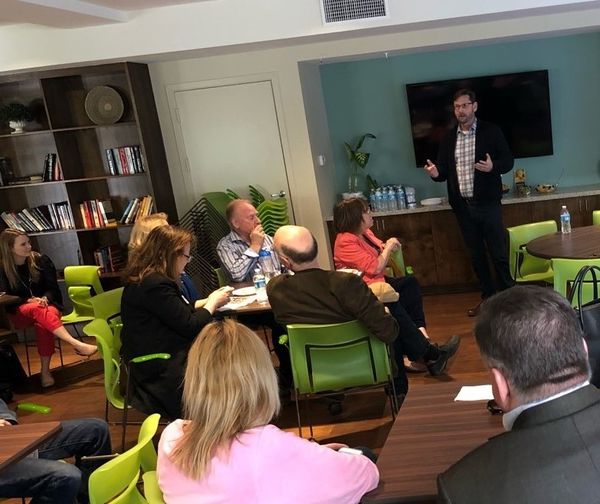Voters passed Proposition HHH in November 2016, a $1.2 billion bond measure by the city of Los Angeles to provide supplemental funding for new permanent supportive housing, and Measure H in March 2017, which will generate about $355 million annually for homeless programs over the next 10 years. Behind the scenes, a strong collaborative effort between the public, private and service sectors was essential in setting up the conditions for Proposition HHH and Measure H to pass.

Thomas Booth, Homelessness Liaison for West Hills Neighborhood Council, with community advocates.
To further understand the efforts that made this possible, the Conrad N. Foundation asked evaluation partner Abt Associates, Inc., to conduct research and interviews within the community to learn more. We are excited to share with you Developing and Passing Proposition HHH and Measure H: How It Happened and Lessons Learned.
While the report provides a detailed look at the evolution of the political will and community support needed, we asked Tommy Newman, United Way of Greater Los Angeles’ Director of Public Affairs, to share an insider’s look at what is next in engaging Angelenos and how this may work in your community. Newman speaks to the significance of these measures, as well as what supporters can do to more effectively communicate this to our communities:
As a community, we have worked tirelessly over the last decade to create a service system that has the functionality to end homelessness—and then worked tirelessly to secure the dedicated revenue to make it happen. We are now at perhaps the most pivotal moment of this generational challenge: scaling up, delivering the services, and building the housing.

The good thing is that the public at large fully understands this moment. Recent focus groups and polling tells us that the people who supported recent ballot measures have reasonable expectations as to the likely pace of progress, and they want to play a role in getting there. This should not be confused as a mandate to build, build, build. To essentially double the existing supply of supportive housing, we’ll have to be more intentional and strategic in how we both talk about what supportive housing is and engage communities to support it.
Here are the key learnings from recent research and wide ranging conversations with the developing community that will help us do just that:
1) The people who will benefit are the key. Often we start out the conversation about supportive housing by touting the policy and financial benefits that it offers. We should always instead start with a real life example of someone who has benefited— this is a much more effective hook.
2) Explain supportive services—in detail. In recent focus groups we repeatedly heard, “I don’t like this supportive housing thing, but if there was a full time on site staff who was professionally trained to work with those in building then I’d support it.” We’re happy to report that’s exactly the case—but no one knows that just by hearing the phrase “supportive housing”.
3) Don’t downplay safety concerns—embrace them. A legitimate communications strategy is to avoid highlighting topics that do not move the ball forward. In this case, safety is the number one question. They can’t be avoided. So instead be ready to talk about how buildings are designed and operated to ensure everyone’s safety—the residents of the building and the surrounding community. The full-time on site building manager as well as the full-time on site case managers are powerful facts.
4) Highlight the less known components of building operations. The perception is that “housing first” means “no rules.” That’s not the case. Every tenant has a lease and understands that, because they are living in a community with others, respect for others is key. While the goal is to keep tenants housed, that goal is certainly balanced with the need for tenants to respect each other and the staff that works on site.
These four strategies may sound simple, but that’s because most people are just now starting to learn about what works to end homelessness and how supportive housing operates. It is up to all of us to help share information and make sure that, as we work to build more supportive housing than ever before, we are always moving the ball forward.
Developed by Abt Associates, Inc.